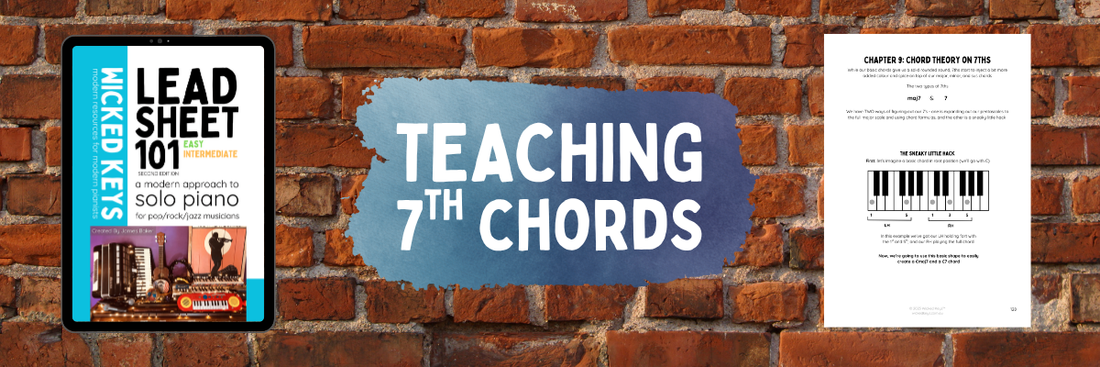
A Guide to Learning and Teaching 7th Chords
Share
This article is an excerpt from Chapter 9 of "Lead Sheet 101: a modern approach to solo piano"
Chord Theory: 7th Chords
While our basic chords give us a solid rounded sound, 7ths start to inject a bit more added colour and spice on top of our major, minor, and sus chords
The two types of 7ths
maj7 & 7
We have TWO ways of figuring out our 7's - one is expanding out our pentascales to the full major scale and using chord formulas, and the other is a sneaky little hack
The sneaky little hack
First: let’s imagine a basic chord in root position (we’ll go with C)

In this example we’ve got our LH holding fort with the 1st and 5th, and our RH playing the full chord
Now, we’re going to use this basic shape to easily create a Cmaj7 and a C7 chord
Cmaj7
In order to turn our basic C chord into a Cmaj7 all we need to do is drop the 1 in our RH voicing down by a semitone/half-step

And BAM! We’ve got a Cmaj7
So: to turn ANY major chord into a maj7 chord, just drop the 1 down a semitone/half-step
C7
In order to turn our basic C chord into a C7 all we need to do is drop the 1 in our RH voicing down by a tone/step

And BAM! We’ve got a C7
So: to turn ANY major chord into a 7 chord, just drop the 1 down a tone/step
We can also do the same with our minor chords
Cm(maj7)
In order to turn our basic Cm chord into a Cm(maj7) all we need to do is drop the 1 in our RH voicing down by a semitone/half-step

And BAM! We’ve got a Cm(maj7)
So: to turn ANY minor chord into a m(maj7) chord, just drop the 1 down a semitone/half-step
Cm7
In order to turn our basic Cm chord into a Cm7 all we need to do is drop our 1 in our RH voicing down by a tone/step

And BAM! We’ve got a Cm7
So: to turn ANY minor chord into a m7 chord, just drop the 1 down a tone/step
The “Proper” Way: Chord Formulas
We can use our major scales and a couple of chord formulas to figure out any chord
C Major Scale

This is where it get’s a little tricky:
maj7's are the “normal” or “naturally occuring” 7th in our scale, whereas 7 chords utilise a “minor 7th”
So, the formula for a Cmaj7 is:
1 3 5 7 (C E G B)
And the formula for a C7 is:
1 3 5 b7 (C E G Bb)
(we drop the maj7 down by a semitone)
Common 7th Chord Formulas
The basics:
Cmaj7 = 1 3 5 7
C7 = 1 3 5 b7
Cm7 = 1 b3 5 b7
The Sus’s
C7sus4 = 1 4 5 b7
C7sus2 = 1 2 5 b7
The more complex:
Cm(maj7) = 1 b3 5 7
Cm7(b5) = 1 b3 b5 b7
C7(#5) = 1 3 #5 b7
Cdim7 = 1 b3 b5 6
(technically the 6 is a double flat 7)
Remember:
The two types of seventh chords:
maj7 and 7
maj7 means the 7th note of the chords major scale
7 means the “flat 7th” note of the chords major scale
“BUT WAIT?!”
(we hear you shouting again)
If “7” means flat 7 WHY don’t we write b7?
GOOD QUESTION!
It’s to avoid confusion with our flat chords (Bb, Eb, Ab etc). If we used b7, when an Ab7 crops up would that mean an A with a b7 or an Ab with a 7?
You can see that’d get pretty confusing pretty quickly!
SO, to avoid confusion with our regular ol’ flat chords we use “maj7” to mean the naturally occuring seventh in the major scale, and “7” to mean the flat seventh of the major scale
 This article is an excerpt from Chapter 9 of "Lead Sheet 101: a modern approach to solo piano"
This article is an excerpt from Chapter 9 of "Lead Sheet 101: a modern approach to solo piano"




![Lead Sheet 101 eBook [Single License] Pay What You Can](http://wickedkeys.com.au/cdn/shop/files/wickedkeys.com.au.png?v=1760493645&width=533)
![An Easy Christmas eBook [Single License] Pay What You Can](http://wickedkeys.com.au/cdn/shop/files/Product_Cards-2.png?v=1760559825&width=533)








![[COMING SOON] Junior Jazz Vol. 1](http://wickedkeys.com.au/cdn/shop/files/22_497fc077-4911-4527-bfad-a7749288e7ca.png?v=1759207635&width=533)
![[COMING SOON] Beginner Blues Vol. 1](http://wickedkeys.com.au/cdn/shop/files/23_844563d1-4c1b-4d59-97de-72c8f9c5122a.png?v=1759207694&width=533)
![[COMING SOON] Accompanying 101](http://wickedkeys.com.au/cdn/shop/files/18_f4c8b907-7385-46b3-801a-77b28cf7d83d.png?v=1759143867&width=533)
![[COMING SOON] Lead Sheet 102](http://wickedkeys.com.au/cdn/shop/files/17_5e2c6a47-e49a-4de2-b4d8-c72a4ed236f6.png?v=1759143867&width=533)
![[COMING SOON] The Business of Teaching Music](http://wickedkeys.com.au/cdn/shop/files/13_9b7bd319-bf2d-4b22-997d-4df4caa52375.png?v=1759143866&width=533)